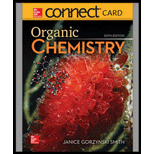
ORGANIC CHEMISTRY-ACCESS
6th Edition
ISBN: 9781260475586
Author: SMITH
Publisher: MCG
expand_more
expand_more
format_list_bulleted
Concept explainers
Question
Chapter 26.10, Problem 24P
Interpretation Introduction
Interpretation: The two aldoses which yield
Concept introduction: Carbohydrate containing
Expert Solution & Answer
Want to see the full answer?
Check out a sample textbook solution
Students have asked these similar questions
What would be the reagents and conditions above and below the arrow that will complete the proposed acetoacetic ester synthesis? If it cannot be done efficiently, then I will choose that answer. There could be 2 or 4 reagents involved. Please provide a detailed explanation and drawings showing how it would proceed with the correct reagents.
For benzene, the ∆H° of vaporization is 30.72 kJ/mol and the ∆S° of vaporization is 86.97 J/mol・K. At 1.00 atm and 228.0 K, what is the ∆G° of vaporization for benzene, in kJ/mol?
The reaction Q(g) + R(g) → Z(l) is shown to be exothermic. Which of the following is true concerning the reaction.
it is spontaneous only at High T, it is spontaneous at low T
it is nonspontaneous at all T
it is spontanrous at all T.
it is non spontaneous only at low T.
Chapter 26 Solutions
ORGANIC CHEMISTRY-ACCESS
Ch. 26.2 - Prob. 1PCh. 26.2 - Prob. 2PCh. 26.2 - Label each stereogenic center as R or S. a. b. c....Ch. 26.2 - Convert the ball-and-stick model to a Fischer...Ch. 26.2 - Prob. 5PCh. 26.2 - Prob. 6PCh. 26.3 - Prob. 7PCh. 26.3 - Prob. 8PCh. 26.4 - Prob. 9PCh. 26.4 - Prob. 10P
Ch. 26.6 - Prob. 11PCh. 26.6 - Prob. 12PCh. 26.6 - Prob. 13PCh. 26.6 - Prob. 14PCh. 26.6 - Prob. 15PCh. 26.7 - Prob. 16PCh. 26.7 - Draw a stepwise mechanism for the following...Ch. 26.7 - Prob. 18PCh. 26.8 - Prob. 19PCh. 26.9 - Prob. 20PCh. 26.9 - Prob. 21PCh. 26.9 - Draw the products formed when D-arabinose is...Ch. 26.9 - Prob. 23PCh. 26.10 - Prob. 24PCh. 26.10 - Prob. 25PCh. 26.10 - Prob. 26PCh. 26.10 - Prob. 27PCh. 26.11 - Prob. 28PCh. 26.11 - Prob. 29PCh. 26.12 - Prob. 30PCh. 26.12 - Prob. 31PCh. 26.13 - Prob. 32PCh. 26.13 - Prob. 33PCh. 26.13 - Problem-28.35
Draw the structures of the...Ch. 26.13 - Prob. 35PCh. 26 - 28.37 Convert each ball-and-stick model to a...Ch. 26 - Prob. 37PCh. 26 - Prob. 38PCh. 26 - 28.40 Convert each compound to a Fischer...Ch. 26 - Prob. 40PCh. 26 - Prob. 41PCh. 26 - 28.43 Draw a Haworth projection for each compound...Ch. 26 - Prob. 43PCh. 26 - 28.45 Draw both pyranose anomers of each...Ch. 26 - Prob. 45PCh. 26 - 28.50 Draw the products formed when D-altrose is...Ch. 26 - 28.58 Draw a stepwise mechanism for the following...Ch. 26 - Prob. 62PCh. 26 - Prob. 63PCh. 26 - Prob. 64PCh. 26 - Prob. 65PCh. 26 - Prob. 66PCh. 26 - Prob. 67PCh. 26 - Prob. 68PCh. 26 - Prob. 69PCh. 26 - Prob. 70P
Knowledge Booster
Learn more about
Need a deep-dive on the concept behind this application? Look no further. Learn more about this topic, chemistry and related others by exploring similar questions and additional content below.Similar questions
- The reaction Q(g) + R(g) → Z(l) is shown to be exothermic. Which of the following is true concerning the reactionarrow_forwardWhich of the following has the largest standard molar entropy, S° (298.15 K) He H2 NaCl KBr Hgarrow_forwardWhich of the following is true for a particular reaction if ∆G° is -40.0 kJ/mol at 290 K and –20.0 kJ/mol at 390 K?arrow_forward
- Choose the major product of the reaction with correct regio- and stereochemistry. Br2 H₂O O "Br Br & O 'Br OH Br 吡 O OH OH Br "OH Brarrow_forwardSelect the major product of the following reaction. & Br (CH)CONa (CH₂),COH 0 OC(CH) O &arrow_forwardDraw the products of the hydrolysis reaction between the ester molecule and water. Determine the products of the following reaction.arrow_forward
arrow_back_ios
SEE MORE QUESTIONS
arrow_forward_ios
Recommended textbooks for you
